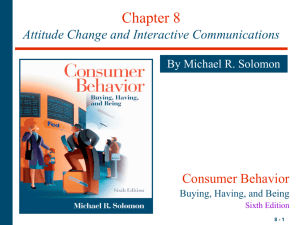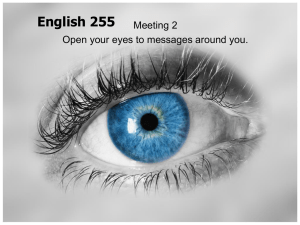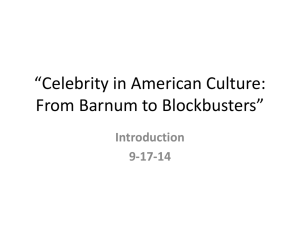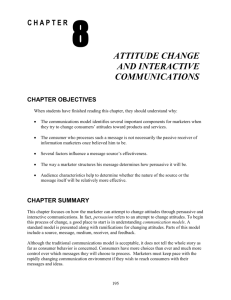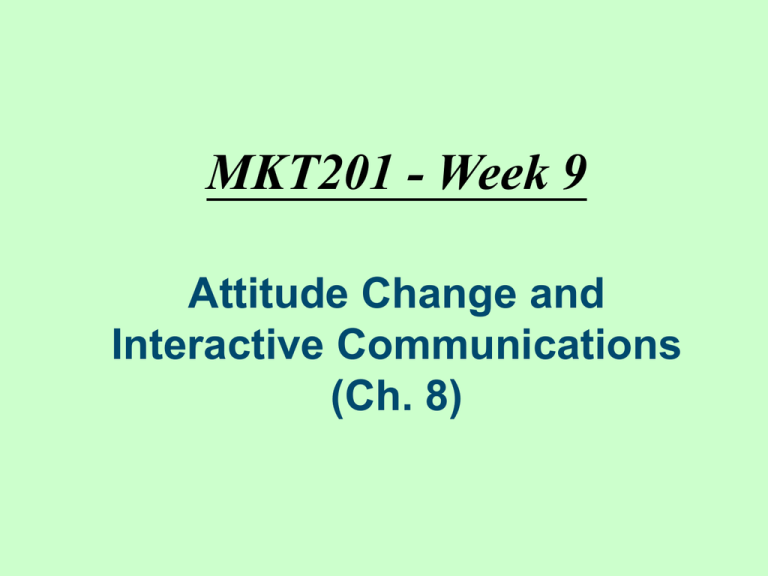
MKT201 - Week 9
Attitude Change and
Interactive Communications
(Ch. 8)
Changing Attitudes
Through Communication
• Persuasion:
– An active attempt to change attitudes
– Basic psychological principles that influence people to change
their minds or comply with a request:
•
•
•
•
•
Reciprocity (social exchange, e.g. incentives for survey)
Scarcity (less available -> more attractive; limited edition)
Authority (who delivers the message)
Consistency (not contradict oneself in belief & action)
Liking (agree with whom you like or admire, e.g. goodlooking -> better in fund raising)
• Consensus (conformity, follow others’ behaviour)
Decisions, Decisions:
Tactical Communications Options
• Who will be the source of the message?
– Man, woman, child, celebrity, athlete?
• How should message be constructed?
– Emphasize negative consequences?
– Direct comparison with competition?
– Present a fantasy?
• What media will transmit the message?
– Print ad, television, door-to-door, Web site?
• What are the characteristics of the target
market?
– Young, old, frustrated, status-oriented?
(e.g. frustrated consumers -> receptive to fantasy appeal)
The Elements of Communication
• Communications Model:
– Specifies that a number of elements are necessary
for communication to be achieved.
•
•
•
•
Source: Where the communication originates
Message: Content of the message itself
Receivers: Interpret the message
Feedback: Must be received by the source
Launch uses the Web to collect
information from subscribers
Launch
The Traditional Communications Model
Figure 8.1
Changing Attitudes Through Communication
• An Updated View: Interactive Communications
– Uses and Gratifications (Uses and Gratifications Theory)
• Active, goal-directed audience, draw on mass media to
satisfy needs.
– Who’s in Charge of the Remote (Remote Control of TV/VCR)?
• Interactive communication model (see Fig. 8.2)
– Levels of Interactive Response
• First-Order Response (immediate response, e.g.
through direct marketing)
• Second-Order Response (not immediate, response may
happen later)
Uses and Gratifications
• Uses and Gratifications Theory
– Consumers constitute an active, goal-directed
audience that draws on mass media as a resource
to satisfy needs.
– Emphasizes that media compete with other
sources to satisfy needs, and these needs include
diversion/amusement and entertainment, as well
as information.
– Consumers are playing a more proactive role,
more like a partner, in the communications
process. They may actually seek out messages.
Interactive Communications Model
The Interactive Communications Model Takes Into
Consideration That (1) Consumers Have Many More
Choices Available to Them, and (2) Greater Control
Over Which Messages They Will Choose to Process
Sender
(Fig. 8.2)
Sender
Sender
Communication
Medium
Receiver
Receiver
Receiver
New Message Formats
• M-commerce (conduct commerce with a mobile
device such as mobile phone, PDA, smartphone)
– Worldwide revenue will reach $39 billion in 2007!
• Blogging
– Moblogging (mobile + weblog) – camera
phone/handheld device
– Video blogging (vlogging) – video diaries
– Podcasting – own radio, with computers or iPods.
– RSS (Really Simple Syndication) – automatic
updates to computers
– Flogs (fake blogs) – generating buzz
• Discussion: Are flogs ethical?
The Source
•
•
Source effects: A message will have different
effects if communicated by a different source.
Two important source characteristics:
1. Credibility, and
2. Attractiveness
Source Characteristics: Credibility
• Under Most Conditions, the Source of a Message Can
Have a Big Impact on the Likelihood the Message
Will be Accepted.
• One Important Source Characteristic Is:
(1) Source Credibility: Source’s perceived expertise,
objectivity, or trustworthiness.
• Credibility can be enhanced if the source’s
qualifications are perceived as somehow relevant to
the product being endorsed.
• Source should not display either Knowledge or
Reporting Bias in presenting information.
Source Characteristics: Attractiveness
•
Another Important Source Characteristic Is:
(2) Source Attractiveness = Source’s perceived social
value.
• Celebrities are successful endorsers because they embody
Cultural Meanings such as status, social class, gender,
age, or personality types.
• Halo Effect often occurs when persons of high rank on
one dimension are assumed to excel on others as well.
The “what is beautiful is good” stereotype.
• Experts are effective endorsers for products that have
High Performance Risk.
• Celebrities are effective endorsers for products that have
High Social Risk.
Source Characteristics: Credibility
The Sleeper Effect:
• People forget about the –ve source and change
their attitudes
• Explained by
– (1) Dissociative Cue Hypothesis
» over time the message and the source
become disassociated in consumer’s mind
– or (2) Availability-Valence Hypotheses
» emphasizes the selectivity of memory owing
to limited capacity (stronger linkage to
message information than the –ve source)
The Source (cont.)
• Building Credibility: Credibility can be enhanced if the
source’s qualifications are relevant to the product.
• Source Biases:
– Knowledge bias: Implies a source’s knowledge is not
accurate.
– Reporting bias: When a source has the required knowledge,
but the willingness to convey it is compromised
• Hype versus Buzz: The Corporate Paradox
– Corporate Paradox: The more involved a company appears
to be in the dissemination of news about its products, the
less credible it becomes.
• Buzz: Word of mouth, viewed as authentic
• Hype: Corporate propaganda, viewed as inauthentic
Hype vs. Buzz
• Corporate paradox
Table 8.1
Hype
Advertising
Overt
Corporate
Fake
Skepticism
Buzz
Word-of-mouth
Covert (secret)
Grass-roots
Authentic
Credibility
Using Web Sites for Hype
Source Attractiveness in Ads
• To stimulate demand
for milk, an industry
trade group tapped a
huge range of
celebrities to show off
their milk mustaches.
“What Is Beautiful Is Good”
• Halo effect
– Good-looking people are thought
to be smarter, cooler, and happier
– Consistency principle
• Physically attractive
source leads to attitude
change
– Directs attention to marketing
stimuli (ads with attractive
models)
– Beauty = source of information
(especially for attractivenessrelevant products)
“What Is
Beautiful Is
Good” Concept
in Use in this
footwear Ad
Halo Effect
Star Power
• Celebrities as communications sources
– Tiger Woods ~$62 million/year in endorsements!
– Famous faces capture attention and are processed more
efficiently by the brain
– Enhance company images and brand attitudes
• Celebrities embody cultural and product
meanings
• Q-Score for celebrity endorsers (Q = quality; a way
to measure the familiarity and appeal of a brand, company,
celebrity, cartoon character or television show.)
• Match-up hypothesis (celebrity’s image and
endorsed product’s image are similar)
Celebrity Endorsers
• Omega uses tennis
star Anna Kournikova
as a celebrity endorser
Avatars: The manifestation of a Hindu
deity/god/goddess in superhuman or animal form.
• A Swedish firm called
NoDNA offers its own stable
of cyber models such as
Tyra, who is shown here.
• One step shop for Smart
Character solution
• (Nonhuman Endorsers)
The Message
• Sending The Message (picture is better than
wordings)
– Framed: Message in the picture is strongly related to the
copy (when verbal elements are presented with picture)
– Chunk: Visual images allow the receiver to group
information at the time of encoding -> stronger memory
• Vividness:
– Pictures and words can differ in vividness
– Powerful descriptions or graphics command attention and
are more strongly embedded in memory
Issues Regarding Development
of a Message
Message Conveyed in Words or Pictures?
How Often Should Message be Repeated?
Conclusion Drawn or Left to Listener?
Both Sides of Argument Presented?
Compare to Competitors?
Blatant/conspicuous Sexual Appeals Used?
Negative Emotions Aroused?
How Concrete or Vivid Should Arguments and
Imagery Be?
Should Ad be Funny?
Positive and Negative Effects
of Elements in TV Commercials
Dual Component Model
of Brand Attitudes
“One picture is worth more than 10,000 words”
Figure 8.3
Sending the Message
Message Conveyed in Words or Pictures
Verbal Messages
Visual Messages
Stronger in High-Involvement
Situations
Stronger Memory Trace
May Affect Brand Inferences
and Brand Attitudes
Both Pictures and Words Can Differ in Vividness
Repetition Helps Us Remember - But Ads “Wear Out”
Two-Factor Theory
Sending the Message
• Repetition:
– Mere Exposure Phenomenon: People tend to like
things that are more familiar to them, even if they
are not keen on them initially.
– Habituation: Consumer no longer pays attention
to the stimulus because of boredom or fatigue
– Two-factor Theory: Explains the fine line between
familiarity and boredom.
• Positive affect (for repetition): Increases familiarity,
reduces uncertainty
• Negative affect: Boredom increases with each exposure
Two-Factor Theory
Increases
familiarity,
decreases
uncertainty
Wear out
How to
overcome?
Figure 8.4
The Way
Something Is Said
Can Be As
Significant As
What Is Said
Constructing the Argument
• One- Versus Two-Sided Arguments:
– Supportive argument: Presents only positive
arguments
– Two-sided message: Presents positive and negative
info
• Drawing Conclusions
• Comparative Advertising:
– A strategy in which a message compares two or
more recognized brands and compares them on the
basis of attributes.
Constructing the Argument
One- Versus Two-Sided Arguments
Decrease reporting bias
One-Sided or
Supportive
Argument
Two-Sided
Argument
Refutational
Arguments
Drawing Conclusions
Should the Advertiser Draw Conclusions or Leave
It To the Consumer to Decide?
Comparative Advertising
Technique Compares Two Specifically Named
Products and Seems to be Effective for New Products
Types of Message Appeals
• Emotional Versus Rational Appeals:
– Choice depends on the nature of the product and the type of
relationship that consumers have with it
– Recall of ad content tends to be better for “thinking” rather
than “feeling” ads
• Sexual Appeals:
– Sex draws attention to the ad but may be counterproductive
unless the product itself is related to sex
• Humorous Appeals:
– Distraction: Humorous ads inhibit the consumer from
counterarguing (thinking of reasons not to agree with the
message), increasing the likelihood of message acceptance
Emotional vs. Rational
• These ads demonstrate
rational versus emotional
message appeals. At the
time of the initial ad
campaign for the new
Infiniti automobiles, the
ads for rival Lexus (top)
emphasized design and
engineering, while the ads
for Infiniti (bottom) did not
even show the car.
Sexual Appeals
• An ad employing a
sexual appeal.
• Sexual humor can
be effective or
backfire,
depending on the
audience
Humor Appeals
• This ad relies upon humor to communicate the message
that skiers and snowboarders should wear helmets.
Humorous
ads grab our
attention
Types of Message Appeals (cont.)
• Fear Appeals:
– Emphasize the negative consequences that can
occur unless the consumer changes a behavior or
an attitude
– Used mostly in social marketing contexts
– Effective only when the threat is moderate and a
solution is presented
– Threat: The literal content of the message
– Fear: An emotional response to the message
Fear Appeals
• Life insurance
companies often use a
fear appeal to motivate
consumers to buy
policies.
Discussion Question
• In this
advertisement for
Big Red chewing
gum, what type of
advertising appeal
is being used?
• Is this an effective
use of this type of
appeal?
Exercise
What do you think about the Message
Appeals in the website of Adbrownies?
http://www.adbrownies.com/
Types of Message Appeals (cont.)
• The Message as Art Form: Metaphors Be
with You:
– Metaphor: Involves placing two dissimilar objects in a
close relationship such that “A is B”
– Simile: Compares two objects “A is like B”
– Resonance: A form of presentation that combines a play on
words with a relevant picture
• Forms of Story Presentation:
– Drama: Attempt to be experiential, involving the audience
emotionally
– Lecture: A speech where the source speaks directly to the
audience to inform and persuade them
– Transformational Advertising: Consumer associates the
experience of product usage with some subjective sensation
The Message as an Art Form
Symbolic representation
Allegory
•Product or service that has
been personified by a
character. (Jolly Green Giant)
Symbolic representation
•Involves use of explicit
comparison.
(direct comparison between two unrelated subjects) (Tony the Tiger = Strength)
Metaphor
Resonance
Forms of Story Presentation
•Presentation that combines a
play on words with a relevant
picture.
•Drama - draws viewer into
the action.
•Lecture - source speaks
directly to audience.
Personification (a metaphor)
• Many products are
personified by
make-believe
characters.
• per·son·i·fi·ca·tio
n
– A person or thing
typifying a certain
quality or idea; an
embodiment
Advertising Metaphors
• This Chinese detergent ad uses a handcuff metaphor as
it urges the viewer, “Free yourself from the burden of
handwash.”
The Source vs. The Message:
Sell the Steak or the Sizzle?
• Elaboration Likelihood Model (ELM):
– Assumes that once a customer receives a message, he or she
begins to process it.
• Two Routes to Persuasion:
– (1) The Central Route to Persuasion:
• The processing route taken under conditions of high involvement
• Cognitive Responses (involve active thinking)
– (2) The Peripheral Route to Persuasion
• The processing route taken under conditions of low involvement
• Consumer are Not motivated to really think
• Peripheral Cues (package design, source attractiveness, message
context)
The ELM
Elaboration Likelihood Model
Figure 8.5
Support for the ELM
• The ELM has received a lot of research
support
• Example: Typical ELM Study
– “Thought listing” technique – to study people’s thought
about the ads for a new brand of low-alcohol beer
• Independent variables:
– Message-processing involvement (with or without a gift)
– Argument strength (strong/very good vs. weak)
– Source characteristics (models with different social
attractiveness)
– Findings:
• High involvement subjects had more cognitions
• High involvement subjects swayed by powerful arguments
• Low involvement subjects influenced by attractive sources
ELM: “Steak” or “Sizzle”?
• ELM research indicates that relative
effectiveness of a strong message
and favorable source depends on
consumers’ level of involvement with
advertised product
– Highly involved consumers look for “steak”
• Strong message arguments
– Those less involved look for “sizzle”
• Packaging colors/images, celebrity endorsers

